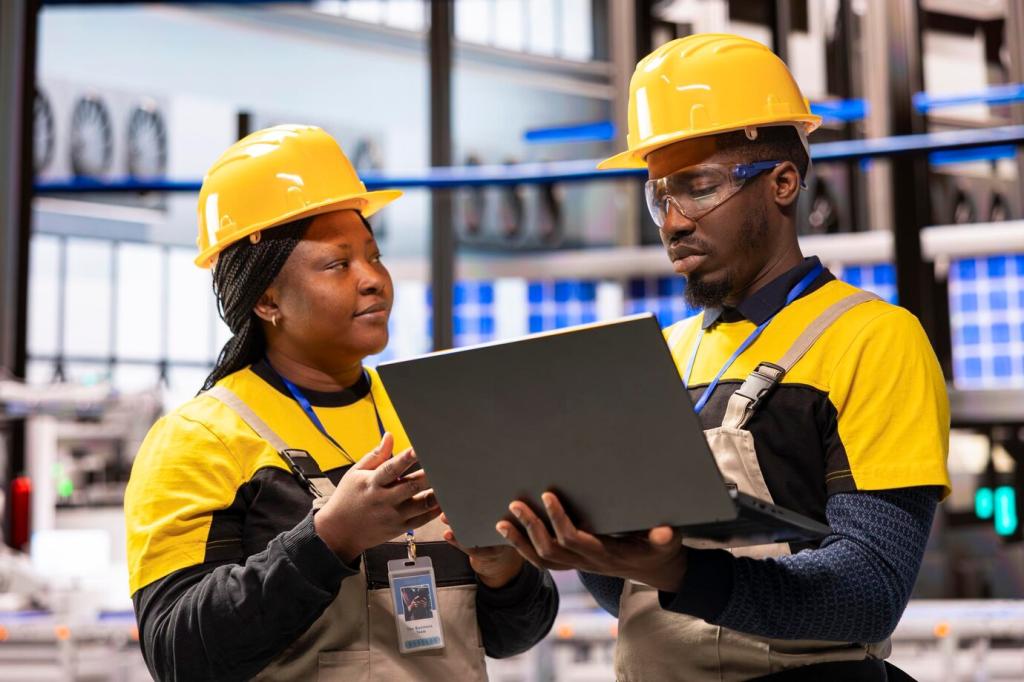IoT Applications in Warehouse Automation: From Real-Time Insight to Relentless Flow
Chosen theme: IoT Applications in Warehouse Automation. Step onto the floor where shelves signal, pallets speak, and machines whisper health checks. Let’s explore practical, human-centered innovations that make every movement count—then share your questions, ideas, and wins with our community.
The Sensor-Driven Warehouse: Foundations and Flow
From simple temperature probes to vibration monitors and optical readers, IoT sensors create a shared language of events. When every zone reports context, planners stop guessing and start orchestrating predictable flow.
The Sensor-Driven Warehouse: Foundations and Flow
Wi‑Fi 6 for dense areas, private 5G for mobility, and low-power networks for asset tags ensure resilient coverage. Consistent connectivity means fewer blind spots, cleaner telemetry, and confident, automated decisions.
The Sensor-Driven Warehouse: Foundations and Flow
Edge gateways filter, fuse, and act on data in milliseconds, while cloud platforms learn long-term patterns. Together they reduce latency, lower bandwidth costs, and keep critical workflows moving when the unexpected hits.
Real-Time Inventory Visibility with RFID and Computer Vision
RFID for Fast, Touchless Identification
Gate readers capture pallet and case movements without manual scans, producing time-stamped truth at chokepoints. With standardized tag data, replenishment and picking become smoother, safer, and measurably faster.
Computer Vision That Sees What Humans Miss
High-resolution cameras validate pallet integrity, detect mislabels, and confirm slot availability. Combined with AI, vision systems flag issues before they escalate, improving accuracy without slowing down operators or robots.
Precision Through Standards and Context
Data models aligned to product hierarchies and location schemas transform raw reads into trusted records. Context-rich events power dashboards that reveal shrink, dwell time, and exceptions in plain, actionable terms.
Catching Wear Before It Stops the Line
Vibration, temperature, and current draw signatures reveal misalignment and bearing fatigue well before failure. Predictive models turn subtle deviations into scheduled fixes, protecting throughput during your busiest windows.
Stories from the Floor: A Saved Weekend
A mid-size 3PL saw a rising temperature trend on a conveyor gearbox late Friday. IoT alerts prompted a 30-minute inspection, preventing a Monday breakdown and a costly backlog.
Maintaining Mobile Robots Without Guesswork
AMRs stream battery health, wheel wear, and localization quality. Automated service tickets and adaptive charging keep fleets productive, aligning maintenance windows with low-demand periods to avoid disrupting picks.

Safety, Compliance, and Human-Centered Design
Forklifts and AMRs respect virtual boundaries, slowing in crowded aisles and restricted zones. Proximity sensors alert operators gently but firmly, reducing near-misses while preserving steady material flow.
Safety, Compliance, and Human-Centered Design
Ergonomic wearables monitor posture, strain, and heat stress, prompting micro-breaks and safer lifts. Data aggregates into coaching insights that improve well-being without micromanaging the rhythm of work.
Energy and Sustainability Optimization
Occupancy sensors dim lights and tune airflow dynamically by aisle and shift. Real-time adjustments reduce energy spikes and keep workers comfortable, even as demand patterns evolve day to day.

Cybersecurity and Resilience in Connected Operations
Segment networks, authenticate every device, and restrict east–west traffic. With least-privilege policies, a misconfigured sensor becomes a contained blip—not a facility-wide incident.
From Pilot to Network-Wide Rollout
Choose a representative process, define clear success criteria, and instrument for learning. Good pilots prove value and reveal integration needs across WMS, WES, and safety systems.
From Pilot to Network-Wide Rollout
Track lead time, pick accuracy, dwell time, and exception rates alongside labor and energy impacts. Tie outcomes to customer promises so improvements resonate beyond the warehouse.


Digital Twins for Continuous Improvement
A Living Model of Your Floor
Digital twins mirror racks, conveyors, robots, and staffing levels, fed by real IoT streams. Planners explore changes safely and discover unexpected constraints before they appear in reality.
Stress-Testing Peak Season
Model surge orders, slotting strategies, and staffing plans under variable lead times. Data-driven experiments reduce overtime spikes while protecting on-time performance when demand surges rapidly.
Close the Loop with Real KPIs
Observed results flow back into the model, sharpening forecasts and rules. Over time, your twin becomes a trusted coach that proposes small changes with outsized operational impact.
